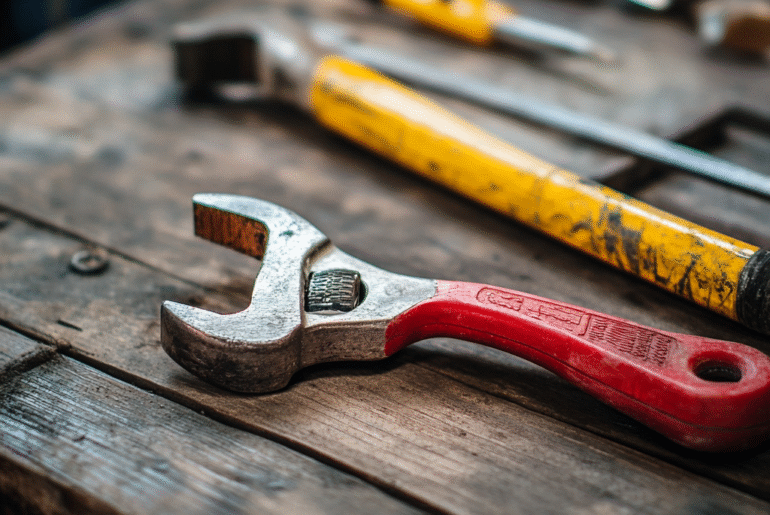This article may contain references to products or services from one or more of our advertisers or partners. We may receive compensation when you click on links to those products or services. Nonetheless, our opinions are our own.
The information presented in this article is accurate to the best of our knowledge at the time of publication. However, information is subject to change, and no guarantees are made about the continued accuracy or completeness of this content after its publication date.
Your skills and knowledge can help you maintain your home effectively. This is true not only for the safety of your home but also for your wallet. Have you ever had to deal with a leaky faucet or a door that wouldn’t close? You might feel nervous about the time and money it will take to call a professional. But what if you could solve a lot of these common household problems on your own with a little practice and the right help?
You’ll learn about 20 essential DIY home repair skills that can empower you to take charge of your home maintenance. Not only will mastering these skills save you money on repair bills, but it will also give you the confidence to handle future challenges with ease. Gather your toolbox and prepare to explore the realm of DIY, where some knowledge can be quite helpful.
- Essential Tools Every DIYer Should Have
- Common Home Repairs That Save You Money
- Minor Plumbing Fixes
- Basic Electrical Fixes You Can Handle
- Simple Techniques to Repair Drywall
- Creating a Maintenance Schedule
- Conclusion
- Frequently Asked Questions
- What are essential DIY home repair skills I should learn?
- How can I fix a leaky faucet?
- What’s the best way to patch drywall?
- How do I unclog a drain effectively?
- What are the basics of painting interior walls?
- How can I change a light fixture safely?
- Is it difficult to perform basic electrical work?
- What tools are necessary for DIY home repairs?
- How can learning these skills save me money?
- Are there online resources to help me learn these skills?
- Can I find local workshops for DIY training?
- What if a repair seems too complicated?
- Will these skills help with ongoing maintenance?
- How can I practice before doing real repairs?
- Are DIY repairs environmentally friendly?
- What mindset helps with learning DIY skills?
- Is there a time commitment involved?
- Recommended Reads
Essential Tools Every DIYer Should Have
When you decide to fix things around the house yourself, having the right tools can make a big difference in how well your project goes and how much fun you have. Buying a good set of tools can help you do a lot of things, which will save you time and money. Here are some essentials you should consider:
- Claw Hammer: A must-have for hanging pictures, assembling furniture, or any project involving nails.
- Screwdriver Set: Includes both flathead and Phillips screwdrivers to handle various assemblies and repairs.
- Measuring Tape: Precision is important in DIY work, making this indispensable for accurate cuts and placements.
- Pliers: Useful for gripping, twisting, and cutting wires.
- Utility Knife: Perfect for cutting materials, packaging, and more.
- Level: Ensures shelves and frames are properly aligned.
- Drill/Driver: A versatile tool for drilling holes or driving screws; look for cordless models for convenience.
- Stud Finder: Crucial for finding secure points in walls before mounting heavy items.
Common Home Repairs That Save You Money
By learning a few practical skills, you can tackle small issues before they turn into major expenses.
- Fixing Leaky Faucets: Prevents wasted water and high utility bills.
- Unclogging Drains: Helps avoid costly plumbing services.
- Sealing Windows and Doors: Reduces energy loss and cuts heating/cooling costs.
- Patching Drywall: Improves aesthetics and prevents further damage.
- Changing Light Fixtures: An easy upgrade that boosts energy efficiency.
DIY vs. Professional Repair Cost Table
| Repair Task | DIY Cost | Professional Cost |
|---|---|---|
| Leaky Faucet | $10-$50 for parts | $150-$300 |
| Clogged Drain | $5-$20 for tools | $100-$200 |
| Drywall Repair | $20-$100 for materials | $100-$400 |
Minor Plumbing Fixes
Plumbing issues don’t always require a professional. Here’s how to handle common ones:
- Leaky Faucet: Turn off the water supply, disassemble the faucet, replace the washer, then reassemble.
- Clogged Drain: Use a plunger or drain snake. A baking soda and vinegar mix, followed by hot water, also works.
- Running Toilet: Inspect and replace the fill valve or flapper if needed.
Tools You’ll Need: Wrench, screwdriver, plumber’s tape.
Voted "Best Overall Budgeting App" by Forbes and WSJ
Monarch Money helps you budget, track spending, set goals, and plan your financial future—all in one app.
Get 50% OFF your first year with code MONARCHVIP
Basic Electrical Fixes You Can Handle
Tackling simple electrical jobs can save money and boost your confidence:
- Replace a Light Fixture: Turn off the power, remove the old fixture, and connect the new one according to the manual.
- Test GFCI Outlets: Press the reset button to restore power.
- Change a Smoke Detector Battery: Should be done every six months.
Electrical Fixes Table
| Fix | Tools Needed | Time Required |
|---|---|---|
| Replace Light Switch | Screwdriver, Voltage Tester | 15 minutes |
| Install Ceiling Fan | Screwdriver, Ladder | 1 hour |
| Change Outlet Cover | Screwdriver | 5 minutes |
Always turn off power before working on electrical systems and call a professional for anything complex.
Simple Techniques to Repair Drywall
Drywall damage is common and easily repaired:
- Assess Damage: Determine if it’s a nail hole or a larger gouge.
- Patch Small Holes: Apply joint compound, smooth with a putty knife, let it dry, sand, and paint.
- Repair Larger Holes: Insert a drywall patch, secure it, feather joint compound over the edges, and sand once dry.
Drywall Repair Supply Table
| Supply | Purpose |
|---|---|
| Joint Compound | Fills and smooths damaged areas |
| Putty Knife | Applies and spreads compound |
| Sanding Sponge | Smooths the repaired surface |
| Primer | Prepares the wall for painting |
| Matching Paint | Refreshes appearance |
Creating a Maintenance Schedule
A regular maintenance schedule keeps your home in top shape and prevents small issues from becoming expensive.
Seasonal Maintenance Examples:
- Spring: Inspect the roof, service A/C, clean garage
- Summer: Test sprinklers, power wash, inspect window seals
- Fall: Clean gutters, prep heating system, check insulation
- Winter: Monitor drafts, check plumbing, prep snow tools
Monthly Checklist Table
| Month | Task |
|---|---|
| January | Check smoke alarms and CO detectors |
| February | Inspect plumbing for leaks |
| March | Service HVAC system |
| April | Clean gutters and downspouts |
Use a calendar reminder system to stay organized and consistent.
Conclusion
One of the best ways to save money, boost your confidence, and raise the value of your home is to learn how to do basic home repairs yourself. These basic skills give you the power to take charge of your surroundings and rely less on expensive professionals. You can seal a window, fix a faucet, or put up a new light fixture. Even first-time homeowners can easily fix common problems if they have the right tools, a good schedule, and some practice. Embrace the learning process and enjoy the financial and personal rewards of maintaining your home like a pro.
Frequently Asked Questions
What are essential DIY home repair skills I should learn?
Fixing faucets, patching drywall, unclogging drains, painting, and basic electrical work.
How can I fix a leaky faucet?
Turn off the water, remove the faucet handle, replace the washer or O-ring, and reassemble.
What’s the best way to patch drywall?
Cut a square around the damage, attach a patch, apply joint compound, sand, and paint.
How do I unclog a drain effectively?
Try a plunger or drain snake. Use baking soda and vinegar followed by hot water if needed.
What are the basics of painting interior walls?
Tape edges, apply primer, and use two coats of paint with a roller and brush for corners.
How can I change a light fixture safely?
Turn off the circuit breaker, match wiring, secure the new fixture, and restore power.
Is it difficult to perform basic electrical work?
You can fix a leaky faucet if you comprehend the process and switch off the power.
What tools are necessary for DIY home repairs?
Hammer, screwdriver set, drill, pliers, tape measure, level, and utility knife.
How can learning these skills save me money?
You avoid labor costs and can prevent small issues from becoming large expenses.
Are there online resources to help me learn these skills?
Yes. YouTube, home repair blogs, and DIY websites offer helpful video tutorials.
Can I find local workshops for DIY training?
Check hardware stores or community colleges for hands-on repair classes.
What if a repair seems too complicated?
Call a professional to avoid injury or further damage.
Will these skills help with ongoing maintenance?
Absolutely, they extend the life and efficiency of your home.
How can I practice before doing real repairs?
Start small with craft or furniture projects, or volunteer for local repair programs.
Are DIY repairs environmentally friendly?
Yes, repairing reduces waste and helps repurpose materials responsibly.
What mindset helps with learning DIY skills?
Stay patient, curious, and open to trial and error. Confidence comes with practice.
Is there a time commitment involved?
Yes, some skills take hours; others take days. Dedicate regular time and learn at your own pace.

Reviewed and edited by Albert Fang.
See a typo or want to suggest an edit/revision to the content? Use the contact us form to provide feedback.
At FangWallet, we value editorial integrity and open collaboration in curating quality content for readers to enjoy. Much appreciated for the assist.
Did you like our article and find it insightful? We encourage sharing the article link with family and friends to benefit as well - better yet, sharing on social media. Thank you for the support! 🍉
Article Title: Learn These 20 DIY Home Repair Skills and Save Big
https://fangwallet.com/2025/08/06/learn-these-20-diy-home-repair-skills-and-save-big/The FangWallet Promise
FangWallet is an editorially independent resource - founded on breaking down challenging financial concepts for anyone to understand since 2014. While we adhere to editorial integrity, note that this post may contain references to products from our partners.
The FangWallet promise is always to have your best interest in mind and be transparent and honest about the financial picture.
Become an Insider

Subscribe to get a free daily budget planner printable to help get your money on track!
Make passive money the right way. No spam.
Editorial Disclaimer: The editorial content on this page is not provided by any of the companies mentioned. The opinions expressed here are the author's alone.
The content of this website is for informational purposes only and does not represent investment advice, or an offer or solicitation to buy or sell any security, investment, or product. Investors are encouraged to do their own due diligence, and, if necessary, consult professional advising before making any investment decisions. Investing involves a high degree of risk, and financial losses may occur including the potential loss of principal.
Source Citation References:
+ Inspo
There are no additional citations or references to note for this article at this time.












































